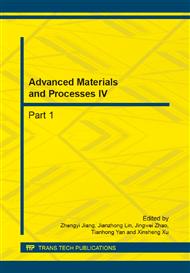p.836
p.841
p.845
p.850
p.854
p.858
p.865
p.870
p.874
Research on Cathode Chronopotentiograms and Interelectrode Resistance during Vacuum Boiling Electroforming
Abstract:
Studies have showed that the electrolyte vacuum boiling electroforming process can significantly improve surface quality and microstructures of the deposited layer. To explore the mechanisms that produce the above-mentioned favorable improvements, this paper focused on analyzing the change characteristics of cathode potential and interelectrode resistance carried out under different process conditions. Research results showed that, reducing vacuum degree or increasing cathode surface temperature result in an intense fluctuation in the cathode chronopotentiometry and interelectrode resistance; decreasing the vacuum degree causes the whole cathode chronopotentiometry to shift negatively, but situation is opposite when the cathode surface temperature rises.
Info:
Periodical:
Pages:
854-857
Citation:
Online since:
September 2014
Authors:
Price:
Сopyright:
© 2014 Trans Tech Publications Ltd. All Rights Reserved
Share:
Citation:


